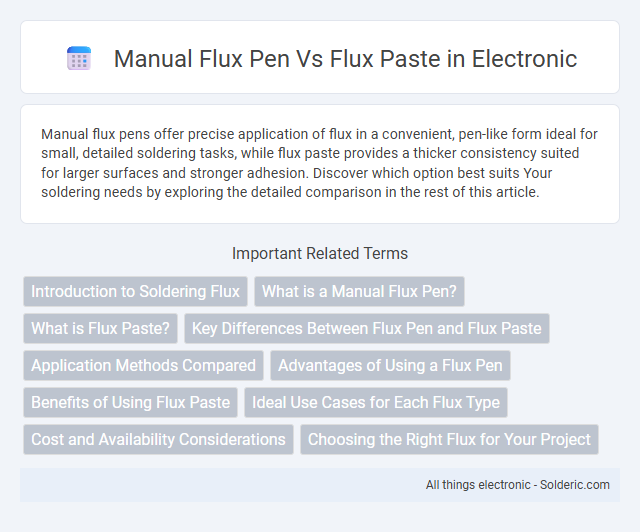Manual flux pens offer precise application of flux in a convenient, pen-like form ideal for small, detailed soldering tasks, while flux paste provides a thicker consistency suited for larger surfaces and stronger adhesion. Discover which option best suits Your soldering needs by exploring the detailed comparison in the rest of this article.
Comparison Table
| Feature | Manual Flux Pen | Flux Paste |
|---|---|---|
| Application Method | Pen tip for precise, controlled application | Applied with brush or spatula, less precise |
| Flux Consistency | Liquid, thin consistency | Thick, viscous paste |
| Use Case | Ideal for small, detailed soldering tasks | Best for large areas and heavy solder joints |
| Cleanliness | Less mess, minimal residue | Can be messy, may require cleaning |
| Storage & Shelf Life | Long shelf life, easy storage | Shorter shelf life, can dry out |
| Cost Efficiency | Cost-effective for precision work | More economical for bulk applications |
| Examples | Electronics repair, fine solder joints | PCB manufacturing, heavy-duty soldering |
Introduction to Soldering Flux
Soldering flux plays a critical role in ensuring strong, clean solder joints by preventing oxidation and improving metal wettability. Manual flux pens offer precision application, making them ideal for delicate electronic components, while flux paste provides a thicker, more stable layer suitable for larger joints or surfaces. Both types enhance the soldering process by promoting better heat transfer and reducing defects in electrical connections.
What is a Manual Flux Pen?
A Manual Flux Pen is a hand-held tool designed to apply precise amounts of flux during soldering or electronics repair. Unlike flux paste, which is thick and manually spread, a flux pen contains liquid flux delivered through a felt tip, allowing for controlled, accurate application on small or delicate components. This precision reduces excess flux usage, improves solder joint quality, and enhances rework efficiency in PCB assembly.
What is Flux Paste?
Flux paste is a viscous, semisolid substance used in soldering to facilitate the cleaning and preparation of metal surfaces by removing oxides and contaminants, thereby promoting better solder flow and stronger joints. It typically contains activators, rosin, and solvents designed to improve electrical connectivity and mechanical strength in electronic and metalwork applications. Unlike liquid flux or flux pens, flux paste offers controlled application, ideal for delicate or precise soldering tasks where excessive spreading must be avoided.
Key Differences Between Flux Pen and Flux Paste
Flux pens deliver precise application with minimal mess, making them ideal for small or detailed soldering tasks, whereas flux paste offers thicker consistency suited for larger surfaces or heavy-duty jobs. The flux pen's controlled ink flow improves accuracy and reduces waste, while flux paste requires a brush or tool for application, which can lead to uneven spread. Choosing your flux type depends on the project scale and need for precision versus coverage.
Application Methods Compared
Manual flux pens offer precise, controlled application by delivering flux directly onto small, targeted areas, making them ideal for delicate electronics repair and intricate soldering tasks. Flux paste, on the other hand, is thicker and applied using brushes or spatulas, providing a heavier, more robust coating suited for larger surfaces or heavy-duty soldering. The choice between a flux pen and flux paste depends on the required precision and the scale of the soldering job.
Advantages of Using a Flux Pen
Flux pens offer precision and convenience, allowing you to apply flux exactly where needed without mess or waste. Their controlled flow can improve solder joint quality by preventing excess flux residue and reducing oxidation during soldering. By using a flux pen, you can streamline your workflow and ensure consistent, reliable results in your electronic assembly tasks.
Benefits of Using Flux Paste
Flux paste improves soldering by providing better control and precise application, reducing excess residue and minimizing the risk of short circuits. It enhances the wetting process on metal surfaces, ensuring stronger, more reliable solder joints with less rework needed. Compared to manual flux pens, flux paste offers superior heat tolerance and longer active time, which is crucial for complex or high-temperature soldering tasks.
Ideal Use Cases for Each Flux Type
Manual flux pens are ideal for precision soldering tasks such as small electronics repair, rework on printed circuit boards (PCBs), and delicate component soldering due to their controlled and targeted application. Flux paste suits larger surface area soldering jobs, including heavy gauge wires, copper pipes, and plumbing work, where thicker coverage and strong adhesion are necessary. Choosing between a flux pen or paste depends on the soldering project's scale, component sensitivity, and the required application accuracy.
Cost and Availability Considerations
Manual flux pens are generally more cost-effective and widely available in electronics supply stores, making them a convenient choice for small-scale or hobbyist soldering tasks. Flux paste tends to be more expensive and may require purchase from specialized distributors, but it offers greater volume and control for larger or industrial projects. Your choice depends on balancing budget constraints with the scale and accessibility of flux needed for your specific application.
Choosing the Right Flux for Your Project
Selecting between a manual flux pen and flux paste depends on the precision and application method required for your soldering task. Flux pens provide controlled, mess-free application ideal for delicate electronics and tight spaces, while flux paste offers a thicker consistency suited for heavy-duty soldering and better moisture resistance. Understanding the viscosity, spreadability, and cleaning needs helps in choosing the appropriate flux type for improved joint quality and solder flow.
Manual flux pen vs flux paste Infographic

 solderic.com
solderic.com